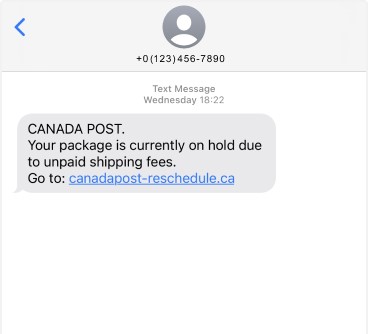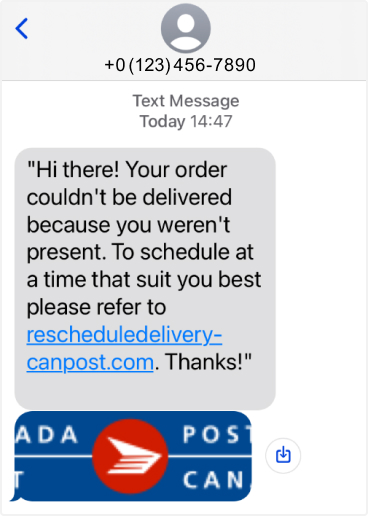Recognizing spam, fraudulent emails and text messages
According to the Canadian Anti-Fraud Centre, "phishing" is a general term for emails, text messages (“smishing”) and websites (“spoofing”) fabricated and sent by criminals and designed to look like they come from well-known and trusted businesses, financial institutions or government agencies to collect personal, financial and sensitive information. It's also known as brand spoofing.
Phishing emails or text messages are intended to trigger a quick reaction and a sense of urgency by asking consumers to "update", "validate", or "confirm" information or “pay” a sum of money otherwise their account will be suspended, or their delivery held, as examples. It is a malicious attempt to collect customer information for the purpose of committing fraud.
Do I need to report suspicious emails or text messages to Canada Post?
No, you don't need to report suspicious emails or text messages to Canada Post.
If you think you've been the victim of fraud, report the incident to the Canadian Anti-Fraud Centre by calling 1-888-495-8501.
You can also forward any spam text messages to 7726 (SPAM on most keypads). This will let your phone provider block future texts from that number.
I received a suspicious email that appears to be from Canada Post. How do I know if it’s legitimate?
We see emails and text messages being circulated from time to time that appear to be from Canada Post. For example, an email might inform a customer that Canada Post tried to deliver a package and asks the customer to select a link or visit a post office to arrange delivery. This is NOT from Canada Post and should be deleted. When Canada Post makes a delivery attempt, we leave a delivery notice card at your door or in your mailbox. We do not contact you by email unless you have requested it.
Canada Post will never reach out to you by email to request credit card or banking information, account information such as your password, or payments to release deliveries and/or see updated tracking information.
Legitimate Canada Post email notifications will only come from Canada Post approved domains and only if you’ve opted into receiving tracking notifications or communications from Canada Post or are dealing with support issues. Examples of legitimate email addresses include:
- donotreply-nepasrepondre@notifications.canadapost-postescanada.ca
- donotreply-nepasrepondre@communications.canadapost-postescanada.ca
- bounce-renvoi@communications.canadapost-postescanada.ca
- bounce-renvoi@notifications.canadapost-postescanada.ca
- claims@canadapost.ca
- donotreply_nepasrepondre@canadapost.ca
What does a suspicious email look like?
Below is an example of a suspicious email. Indications that this is a suspicious email include:
- Generic or no greeting
- Imagery isn’t consistent with Canada Post branding and logos
- Poor grammar and/or typos in the sender name, subject and/or email copy
- Tracking number isn’t consistent with the Canada Post tracking number format
- Sense of urgency by stating that there is an issue with the delivery and if you don’t respond within a certain time, it will be returned to the sender
- Link to download a file and a password
- Link doesn’t point to a legitimate Canada Post webpage with the domain “canadapost-postescanada.ca”
Image of suspicious communications:

I received a suspicious text message that appears to be from Canada Post. How do I know if it’s legitimate?
We see text messages being circulated from time to time that appear to be from Canada Post. For example, a text message might inform a customer that a Canada Post delivery has been put on hold due to unpaid shipping fees and asks the customer to click a link to pay the fee so the delivery can be released. This is NOT from Canada Post and should be deleted. Tracking your delivery on the Canada Post website is the safest way to see if any fees are due, such as duty and taxes.
Canada Post will never reach out to you by text message to request credit card or banking information, account information such as your password, or payments to release deliveries and/or see updated tracking information.
Legitimate Canada Post SMS tracking or mail notifications and marketing communications will only show the sender as 272727 or 55555, and only if you have signed up to receive those notifications. SMS messages may also come from customer support via phone numbers 613-734-1002 and 613-734-1004.
What does a suspicious text look like?
Below are two examples of suspicious texts. Indications that these are suspicious texts include:
- Sense of urgency by saying delivery is on hold because of unpaid fees or because nobody was home to receive the delivery
- Poor grammar and/or typos in the message copy or company name
- Link doesn’t point to a legitimate Canada Post webpage with the domain “canadapost-postescanada.ca”
- Link to download a file
Images of suspicious communications:


How can I Identify potentially fraudulent emails or text messages?
Unfortunately, it is very difficult to stop receiving fraudulent emails or text messages altogether, but you can protect yourself and your personal information by doing the following:
- Unless you have requested email or text notifications, delete them immediately
- Do not click on links in suspicious emails or text messages as they may contain malicious viruses or lead you to a fake website
- Do not provide any personal information including identification, banking details and/or Canada Post login information
- Do not reply to the emails or the text messages, even if the text or email tells you to click on “Unsubscribe” or text “STOP” to stop receiving messages
- Check the senders' addresses in emails for odd names or emails such as “parcel-delivery-canadapost.ca” that don’t align with a typical Canada Post email notification
- Check the number from which a text message has been sent to ensure it is from the trusted Canada Post short code number or phone number. Examples of these include:
- 272727 or 55555
- 613-734-1002
- 613-734-1004
- Look for obvious spelling or grammatical errors in the message or excessive capitalization and exclamation points
- Look for generic greetings such as “Dear Customer”, “Sir” or “Madame”
- Look for misspelled or modified Canada Post website and email addresses such as “Canada-Poste.ca” or “PostalCanada.com”
- Look for instances where the email or text message wants you to “act immediately” to avoid missing a delivery or having your account suspended
- Look for “urgent” requests to click a link to provide account details, or payment details.
Remember: Canada Post does not send unsolicited emails requesting personal information such as credit card numbers, account or invoice numbers, address and or passwords and will not charge you to track or release a delivery.
The best way to find out if a particular alert or message is legitimate is to visit https://www.canadapost-postescanada.ca or the Canada Post mobile app and check your tracking or account details. Never click on a link in an email or text that seems suspicious.
Where can I find out more information on how to protect myself from these types of fraud?
Visit the Canadian Anti-Fraud Centre to learn tips to protect yourself. You can also learn more on phishing and smishing scams by visiting the public safety website.